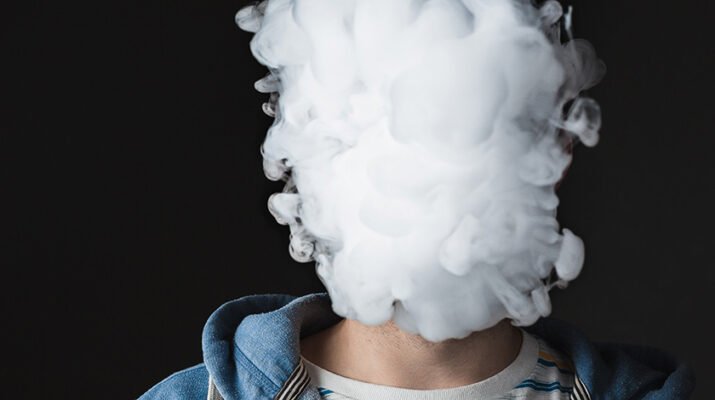Tobacco use was declining… then e-cigarettes came along
By Deborah Jeanne Sergeant
Teens seem to be getting the message on the dangers of smoking cigarettes. Their use continues to plummet among teens.
Among this age group, tobacco use continues largely thanks to vaping. Part of the reason for their popularity is that teens perceive e-cigarettes as safer than incendiary cigarettes.
Originally, vaping was marketed as a tool for smoking cessation, in fact.
“While youth are certainly getting the message that vaping is not what it’s cracked up to be — the rates are declining a little bit — we’re dealing with some youth who get addicted to nicotine at extreme rates because the products have such high concentrations of nicotine,” said Tony Astran, media contact for The New York State Smokers’ Quitline.
The Quitline is a service of the New York State Department of Health and based at Roswell Park Comprehensive Cancer Center in Buffalo.
A Hyde vape contains about 1.8 ml. of liquid, which equals 25-50 mg. of nicotine. That’s equal to one pack of cigarettes. Unlike a cigarette, which burns up to indicate that “serving” of nicotine has been consumed, a vaping device has no clear end point. Using a vape is like eating from a carton of ice cream with a spoon compared with the cigarette, which offers portion control more like that of eating an ice cream sandwich.
Nicotine affects youth differently from adults.
“We know that the brain is still developing up to age 25,” Astran said. “Nicotine can stunt development and cause jitters and lack of focus and other problems, especially important as youth are going to school. This is exactly what you do not want to happen. If you start younger on nicotine, the more likely you’ll get addicted for life.”
The US Food and Drug Administration banned most flavored vaping liquid in 2020. However, the ban covered only flavored cartridges and pods, not tanks or disposable flavored e-cigarettes.
“Big tobacco is constantly trying to stay one step ahead,” Astran said.
Exploiting that loophole has kept candy and fruity flavors — popular with teens — available in the market.
Since e-cigarettes emit vapor, it seems safer than smoky cigarettes. But the vapor contains a mix of largely unknown chemicals not FDA-regulated for inhalation. Most of the vaping liquids on the market are sourced from companies in countries that use less stringent consumer safety standards than the US.
The appeal of the sleek device, which often looks like a USB flash drive, also attracts teens. It’s easy to conceal from their parents because the vapor smells like fruit and the device appears harmless as well.
“Far too many parents aren’t clued in,” said Jenna C. Brinkworth, community outreach and engagement manager for Roswell Park Comprehensive Cancer Center in Buffalo. “It’s not harmless water vapor. It’s highly addictive. They need to know what the devices look like.”
“If they ask, listen and look, those can be really important things to do and to keep in mind. We’re finding that youth who start vaping are more likely to start smoking combustible products. That has the tar and all of those harmful effects. There’s no reason at all for teens to start vaping. Some parents say it’s a better alternative to smoking or other substance but it’s not true,” she added.
Prevention is obviously better than quitting. Parents need to take the lead by setting a good example and not using substances themselves. It may seem like teens want to be anything but like their parents, but the parental example ingrains in children early on what is acceptable behavior.
As always, the peer group also matters. Teens may vape to fit in or appear edgy to their friends.
Teens may vape because they feel it will help them de-stress. For this reason, it’s vital to promote healthy ways of managing stress and to avoid over-scheduling and heaping up unrealistic demands. Teens need downtime as well as adults.
“Teens today have so many challenges,” Brinkworth said. “Stress, anxiety and depression are never like before. Kids who are vaping and using THC have higher stress, anxiety, depression and suicidal thoughts compared with kids who do not use. They are turning to nicotine to relax or be with peers. But it’s only building upon those problems and making it harder to deal with those issues.”
Many healthcare professionals have only begun asking teens about vaping in well child visits.
Bridget Vaccaro, family nurse practitioner and clinical director at Neighborhood Health Center’s Northwest Buffalo location, said that any patient aged 12-21 receives a screening for substance use, including nicotine, “but we don’t include vapes,” she said. “We don’t consider it a tobacco product. I didn’t give a lot of these topics a thought until I had kids, now 9 and 6. I look at them and realize I have to educate parents and families on the things I talk about at home. I know this stuff because I’m an educator and medical professional.”
Use of Tobacco Products
The New York Youth Tobacco Survey reveals that in 2014, 10.5% of New York high school students use e-cigarettes. That percent has climbed to 22.5% in 2020 and, the most recent figure, is 18.7% in 2022. The percent smoking incendiary cigarettes was 7.3% in 2014, 2.4% in 2020 and 2.1% in 2022. Overall tobacco use (cigarettes, vapes and other types such as cigars, oral pouches and cigarillos) has climbed from 19.5% in 2014 to 25.6% in 2020 and dipped down a bit to 20.8% in 2022.
• Vaping cessation resources from the New York State Smokers’ Quitline: https://nysmokefree.com/FactsAndFAQs/Vaping
• The latest in products attracting youth: https://truthinitiative.org/research-resources/emerging-tobacco-products/what-zyn-and-what-are-oral-nicotine-pouches.

